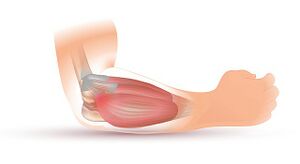Panner's Disease
Top Contributors - Chloe Waller, Shreya Pavaskar and Vidya Acharya
Definition[edit | edit source]
Panner's disease is bone growth disorder (osteochondrosis) of the humeral capitellum ossification centre, at the lateral aspect of the elbow[1].
It is a rare disease, found most commonly in boys under 10 years old, and in a unilateral presentation[2].
Clinically Relevant Anatomy[edit | edit source]
The elbow joint is a synovial hinge joint. The three bones that make up the articulation of the joint are: the distal end of the humerus and proximal ends of the radius and ulna. The capitellum is the smooth, rounded lateral aspect of the distal articular surface of the humerus, which articulates with the head of the radius.
Pathological Process[edit | edit source]
If the blood vessels suppyling the nuleus of the capitellum are disrupted, ischemia can occur, leading to flatterning of the capitellum[2]. This could be due to:
- Repetitive valgus stress (e.g. throwing and catching).
- Increased axial loading[3].
- Trauma to the elbow.
Clinical Presentation[edit | edit source]
- Lateral elbow pain, aggravted by activity and eased with rest[4].
- Elbow stiffness[4].
- Reduced range of motion, especially into extension[5].
- Elbow swelling[4].
Diagnostic Procedures[edit | edit source]
The diagnosis is made on the clinical presentation and age of the patient, in combination with using radiographs and magnetic resonance imaging (MRI's) to look for[6][5][7]:
- Joint effusion.
- Irregular delineation of the joint line.
- Radiolucency (indicating resorption), particularly adjacent to the articular surface.
- Sclerosis.
- Subchondral vacuum phenomenon.
Outcome Measures[edit | edit source]
Management / Interventions[edit | edit source]
Panner's disease can usually be managed with conservative treatment[2] . The arm shoulder be rested, with stopping of aggravating activities, and ice can be used to ease pain and swelling[4]. Physiotherapy can help to stretch and strengthen the elbow as indicated.
If these first line treatments do not improve the symptoms, the elbow can be immobilized/ splinted for a short period[7].
Usually after a period of recovery, the patient can return to their sport.
Differential Diagnosis[edit | edit source]
- The most common differential diagnosis is osteochondritis dissecans[1].
- Lateral epicondylitis[9].
Resources[edit | edit source]
References[edit | edit source]
- ↑ 1.0 1.1 Nordlie H, Rognstad M, Iveland H. Panner's disease. Tidsskr Nor Laegeforen. 2021 Jun 24;141(10). English, Norwegian
- ↑ 2.0 2.1 2.2 Claessen FM, Louwerens JK, Doornberg JN, van Dijk CN, Eygendaal D, van den Bekerom MP. Panner's disease: literature review and treatment recommendations. J Child Orthop. 2015 Feb;9(1):9-17.
- ↑ Leahy I, Schorpion M, Ganley T. Common medial elbow injuries in the adolescent athlete. J Hand Ther. 2015 Apr-Jun;28(2):201-10; quiz 211.
- ↑ 4.0 4.1 4.2 4.3 John Hopkins Medicine. Panner's Disease. Available from: http://www.hopkinsallchildrens.org/Patients-Families/Health-Library/HealthDocNew/Panner-s-Disease (Accessed 14/10/2022)
- ↑ 5.0 5.1 Anisau A, Posadzy M, Vanhoenacker F. Panner's Disease: The Vacuum Phenomenon Revisited. J Belg Soc Radiol. 2018 Oct 12;102(1):67
- ↑ Sakata R, Fujioka H, Tomatsuri M, Kokubu T, Mifune Y, Inui A, Kurosaka M. Treatment and Diagnosis of Panner's Disease. A Report of Three Cases. Kobe J Med Sci. 2015 Apr 22;61(2):E36-9.
- ↑ 7.0 7.1 Chavda S, Abeid KA, Alhajri KK, Hasan NHA. Osteochondrosis of Humeral Capitellum, Diagnosis and Treatment - A Case Report. J Orthop Case Rep. 2021 Jul;11(7):74-77.
- ↑ Overhead Athletics. Panner's Disease and Little Leaguer's Elbow Rehabilitation Exercise and Treatment. Available from:https://www.youtube.com/watch?v=g5E8oXQnjDU (Last accessed 14/10/2022)
- ↑ Kotnis NA, Chiavaras MM, Harish S. Lateral epicondylitis and beyond: imaging of lateral elbow pain with clinical-radiologic correlation. Skeletal Radiol. 2012 Apr;41(4):369-86.
- ↑ Dr Nabil Ebraheim. Panner's Disease - Everything You Need To Know. Available from: https://www.youtube.com/watch?v=3W51jPKXTJ8 (Last accessed 14/10/2022)







